extracting the cable from the inside, if there is one, or making sure
that the turn is open, with no possibility of accidental closure.
Test:
Select and inject the adequate test voltage level.
The voltage that must be selected is the one that corresponds to nominal secondary of
the VT. With very rare exceptions, this will be 100 V, 110 V or 120V. The template uses
the voltage value measured through input V2 for all its calculations, but this
measurement may not be identical to the selected injection value, as the auxiliary power
output is regulated in the primary winding of the internal output transformer of the
equipment. Consequently, and depending on the burden value, a small error may occur
at its real output, due to the fact that we are connecting it in the secondary. If you wish to
exactly inject the nominal value, adjust the selection with the dial until you read this
nominal value on the relative meter.
You will be able to read all the values indicated by the meters during the injection.
If the measurements are seen to be unstable, and their values are continuously changing,
use the FILTER option to see the most stable values.
To stop the injection and finish the test, simply click on the button of the dial.
Short-circuited PT
This template is designed to carry out short-circuited
impedance tests in any Power (PT) or Distribution
Transformer.
This test provides a lot of information about the state of the
internal geometry of the PT, detecting possible movements
of the internal windings due to transport or to a very severe
fault, by comparing the results obtained in each winding.
These must be reasonably balanced.
The Short-circuited Voltage percentage (Vcc%) or the same
percentage defined in Impedance (Z%) may also be
calculated. These are the two ways in which this
information can appear on the technical characteristics plate of the PT. The definition of
the Short-circuited voltage is:

